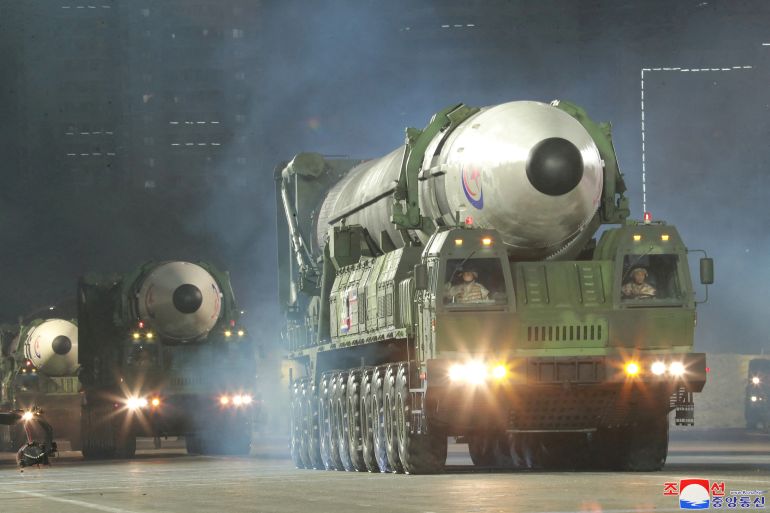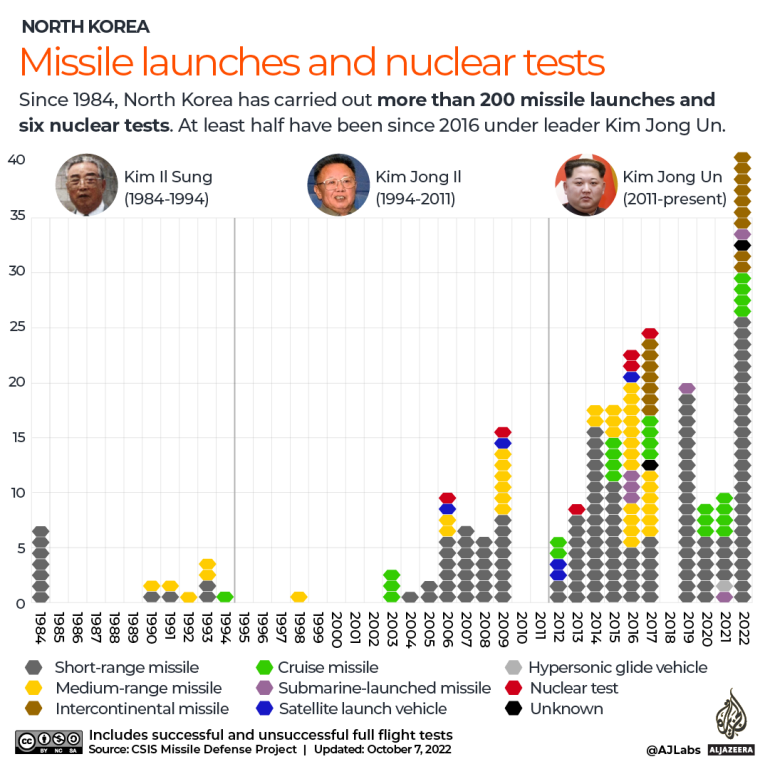North Korea’s missile launches demonstrate growing capabilities
North Korea has launched more than 60 missiles this year. Here are some of the key capabilities it is developing.

North Korea has conducted a record number of missile launches this week, including an apparent intercontinental ballistic missile (ICBM), bringing the total number of missiles fired to more than 60 so far this year.
The nuclear-armed state launched 23 missiles of various types on Wednesday alone, the most in a single day.
Keep reading
list of 4 itemsNorth Korea covertly shipping artillery shells to Russia, US says
S Korea police stations raided in probe of Halloween crush deaths
N Korean missile lands off S Korea coast, Seoul launches response
On Thursday, it fired several ballistic missiles including what was believed to be an ICBM, which are North Korea’s longest-range weapons and are designed to carry a nuclear warhead to the other side of the planet.
South Korean officials believe the ICBM failed in flight, Yonhap news agency reported, and Japanese officials said they lost track of the missile on its flight path – another indication of possible failure.
North Korea began demonstrating its increasingly advanced military capability in January with the launch of a new “hypersonic missile“.
Here are some of the key missile capabilities North Korea is developing:
Long-range launches
North Korea claimed in March to have successfully tested its largest-ever ICBM.
Dubbed the “Monster Missile” by some, the Hwasong-17 cruised at high altitude for more than 67 minutes before splashing down 1,090km (677 miles) away in the Sea of Japan.
South Korean and US officials countered that North Korea had actually fired an older Hwasong-15 ICBM and that some Hwasong-17 tests have previously ended in failure.
North Korea has defended its weapons programme as a legitimate means of defence against what it sees as a decades-old threat from the United States and its allies in South Korea.
On October 4, it fired an intermediate-range missile over Japan and into the Pacific Ocean some 4,600km (2,858 miles) from its launch site.
The return to firing long-range missiles has raised the stakes for the US and other distant countries who fear the growing global reach of the North Korean military.
Manoeuverable missiles
Many of North Korea’s most recent short-range ballistic missiles (SRBMs), such as its KN-23 and KN-24, are designed to fly on a lower, “depressed” trajectory and can potentially manoeuvre, which complicates efforts to detect and intercept them.
North Korea also claims to have tested a new type of hypersonic missile, which usually flies at lower altitudes and faster than a ballistic missile – about 6,200km/h (3,850 mph).
The key feature of hypersonic weapons, however, is not their speed but their manoeuvrability, which can help them avoid interception.
Analysts also say the large size of the Hwasong-17 ICBM suggests that Pyongyang may be looking to pack the missile with multiple, smaller, manoeuvrable nuclear warheads and decoys that can help them evade defences.

Diverse locations
North Korea has test-fired its missiles from different locations and launch platforms. Analysts say this is a conflict-simulation tactic that makes it difficult for enemies to detect and destroy missile launch sites.
In January, North Korea launched a pair of short-range ballistic missiles from a train near its northern border with China.
Despite the country’s limited and sometimes unreliable rail network, rail-mobile missiles are a relatively cheap and efficient option to improve the survivability of their nuclear forces in case of conflict.
North Korea also conducted missile launches from the international airport outside the capital, Pyongyang, and launched a short-range missile from its experimental missile submarine. It has promised that an operational missile submarine would soon be deployed.
Tactical nuclear weapons
If North Korea does resume nuclear testing, it could include the development of smaller “tactical” warheads meant for battlefield use and designed to fit on short-range missiles, according to South Korean officials.
In April, North Korea test-fired a new, short-range missile that state media said was for “enhancing the efficiency in the operation of tactical nukes”. The announcement marked the first time the country had linked a specific system to tactical nuclear weapons usage.
Analysts say putting small warheads on short-range missiles could represent a dangerous change in the way North Korea deploys and plans to use nuclear weapons.
Smaller warheads would allow the North Korean military to field more of them and would allow their use against a wider range of military targets in South Korea.
Ankit Panda, an expert on North Korea’s weapons programme and current Stanton senior fellow at the Carnegie Endowment for International Peace in Washington, DC, estimated that North Korea could have “in the range of 40 to 70 manufactured nuclear warheads”.
“And I think they will continue to produce more weapons-usable fissile material to produce additional nuclear warheads for these systems,” he said in a recent interview with Al Jazeera.